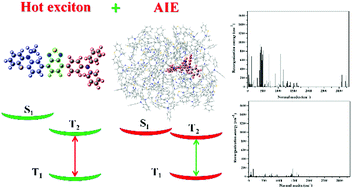Fluorescent emitters with the hot exciton mechanism combined with aggregation induced emission (AIE) character show prospective applications in organic light emitting diodes (OLEDs). However, theoretical studies on amorphous states are limited. In this work, a theoretical study is performed on the photophysical properties of the reported compound 4-(7-(10-ethyl-10H-phenothiazin-3-yl)benzo[c][1,2,5]thiadiazol-4-yl)-N,N-diphenylaniline (PBTPA), which possesses a hot exciton mechanism and AIE. The aggregation states of this molecule in a film are given by molecular dynamics (MD) simulations, and then the photophysical properties are studied by using the QM/MM method with the consideration of the solid-state effect (SSE). The results explain the hot exciton and AIE mechanism of the molecule. First, there is a hot exciton channel between the S1 and T2 state of the PBTPA. Second, the conformational changes of PBTPA between the ground state and the excited state are restricted in the aggregate state. Last, in the low frequency region, the rotation motion is suppressed, and then the reorganization energy and Huang–Rhys (HR) factor in the aggregate state are much smaller. Therefore, the molecules show strong fluorescence efficiency in the aggregated state.
